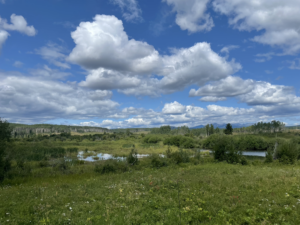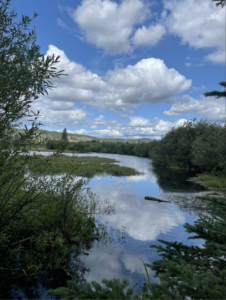Date: 25-07-2024
Time: 1130-1300 hours
Location: Wetland zone on my private property in Quick, British Columbia.
Coordinates: 54.63341° N, 126.87755° W
Weather Conditions: 20˚C, partly cloudy, humidity 41%, pressure 1017hPa, NW wind 14km/h
Observations: The wetland area is approximately 34 acres of swamp and marsh with Robin Creek flowing around the outer edge of the zone. This area of study is quite rural, although a highway runs through about 200 meters East. The water appears to be stagnant as there is no visible movement and lots of vegetation throughout the water. Also, the water looks very murky with high turbidity levels. Dependent upon current seasons, precipitation, and temperature, the wetland varies from being 3 feet deep in the middle to almost entirely dry occasionally. The topography of the site is quite flat, with a slight hill on the southwest forested edge. The surrounding area is forested on the south and west sides and fields on the north and east sides. Although I did not see any North American Beavers (Castor canadensis) this trip, there are multiple lodges in the water, a dam on the edge of Robin Creek, and freshly chewed trees along the edge of the water. In the trees surrounding the water, there are quite a few Red-Winged Blackbirds (Agelaius phoeniceus) singing and cleaning themselves. Lots of Mule Deer (Odocoileus hemionus hemionus), Rocky Mountain Elk (Cervus canadensis nelsoni), and a few Black Bear (Ursus americanus) tracks are in the mud around the water. The field on the east side of the water is full of Common Red Paintbrush (Castilleja miniata), Red Clover (Trifolium pratense), Pink Spirea (Spirea douglasii ssp. menziesii), Trailing Raspberry (Rubus pubescens), Wild Strawberry (Fragaria virginiana), and Cow Parsnip (Heracleum lanatum). The trees surrounding the water are mostly Hybrid White Spruce (Picea glauca x engelmannii), Lodgepole Pine (Pinus contort var. latifolia), and Trembling Aspen (Populus tremuloides). Also, there was lots of Saskatoon (Amelanchier alnifolia), Black Twinberry (Lonicera involucrata), and Red-Osier Dogwood (Cornus stolonifera) shrubs in the surrounding forest or along the edge of the water. There are clusters of Yellow Waterlilies (Nuphar lutea ssp. polysepala) and Cattail’s (Typha latifolia) growing in the water.
Areas of Interest: Potential subjects that I might want to study for my research project are the North American Beavers (Castor canadensis), Red-Winged Blackbirds (Agelaius phoeniceus), Western Toads (Anaxyrus boreas) or the Northern Rice Root’s (Fritillaria camschatcensis) which are residing in the wetland area.
Questions:
- Is there a symbiotic relationship between North American Beavers (Castor canadensis) and Red-Winged Blackbirds (Agelaius phoeniceus)?
- Does the turbidity levels correlate with the current depth of the water?
- Do the size of Northern Rice Root’s (Fritillaria camschatcensis) bulbs correlate to their distance from the water?

Eastern Field
Middle of the Wetland Wildlife Tracks in the Mud


Hi, welcome to the field portion of the course! Sounds like a great study area and some good initial questions! Good luck narrowing things down over the next couple of modules.